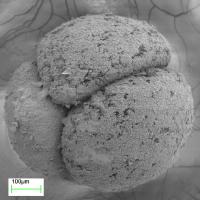
A more-than 551 million year old four-cell embryo magnified using a scanning electronic microscope. The specimen is about 0.65 millimeter in diameter. A group of 15 scientists from five countries has discovered evidence of cell differentiation in fossil embryos that are more than 550 million years old. They also report what appear to be cells about to divide. They used x-ray imaging technologies that produce higher resolutions than hospital-CT scans and digitally extracted cells from the embryos of ancient animals that have been preserved in the Doushantuo Formation, a fossil site in South China.
The discovery will be reported in the Oct. 13 issue of Science, in the article, "Cellular and Subcellular Structure of Neoproterozoic Animal Embryos," by James W. Hagadorn of Amherst College, Shuhai Xiao of Virginia Tech, Philip C.J. Donoghue of the University of Bristol, Stefan Bengtson of the Swedish Museum of Natural History, Neil J. Gostling and Maria Pawlowska of Bristol, Elizabeth C. Raff and Rudolf A. Raff of both Indiana University and the University of Sydney, F. Rudolph Turner of Indiana, Yin Chongyu of the Chinese Academy of Geological Sciences, Chuanming Zhou and Xunlai Yuan of the Nanjing Institute of Geology and paleontology, Matthew B. McFeely of Amherst, Marco Stampanoni of Swiss Light Source at the Paul Scherrer Institute, and Kenneth H. Nealson of the University of Southern California, L.A. 
This image is a volume rendering of a 31-celled animal embryo from the Doushantuo Formation.
"We asked the question – Can subcellular or intracellular structures be preserved within these embryos," said Xiao, associate professor of geosciences at Virginia Tech who has been exploring the Doushantuo Formation for many years and whose group reported the discovery of animal embryo fossils from this formation (Nature, 1998).
"Because the fossils are so small, we used microfocus x-ray computed tomography (microCT), scanning electron microscope, and transmission electron microscope facilities at Amherst College, Swiss Light Source at the Paul Scherrer Institute in Switzerland, Virginia Tech, and Nanjing Institute of Geology and Paleontology to analyze these fossils," Xiao said.
The researchers report in Science that they analyzed "162 relatively pristine envelope-bound and spheroidal embryos in which recurrent biological structures and cleavage patterns could be distinguished from inorganic artifacts."
"We digitally extracted each cell from the embryos and then looked inside the cells," Xiao said. "We found some kidney shaped structures within the cells which could be nuclei or other subcellular structures. It is amazing that such delicate biological structures can be preserved in such an ancient deposit."
In some four-cell embryos, each cell had two kidney shaped subcellular structures, "so they were caught in the process of splitting during cell division," Xiao said.
While the researchers say "may" in the Science article, they justify their cautious conclusion by pointing out, "The size, shape, and mirrored orientation of paired intracellular structures in four-cell embryos are similar to those of spindle bundles or divided nuclei formed during karyokinesis (nuclear division) in extant metazoan (animal) embryos." __IMAGE_3
The research team also observed "occasional asynchronous cell division," where an organism would have 31 cells, instead of 32, for instance. In fact, one in four of the specimens being examined had odd numbers of cells. The researchers felt confident excluding such causes as degradation in the carefully selected sample they were studying. They believe the uneven cell division is a developmental control and is possible evidence "that sophisticated mechanisms for differential cell division timing and embryonic cell lineage differentiation evolved before 551 million years ago," they write in the introduction to the Science article.
"One of the other major conclusions of the work is that we cast serious doubt on previous claims that these embryos represent more derived or advanced groups of animals, for example, bilaterally symmetrical animals" Hagadorn said. "Rather, all the available evidence suggests that the represent relatively simple forms, akin to sponge ancestors."
Xiao reports that the most recent collection of embryos at the Doushantou site was in June. "There are millions of embryos but the later stages of these animals are rare." The research group continues to address the developmental pathways of these early animals.
Source : Virginia Tech
 Print Article
Print Article Mail to a Friend
Mail to a Friend
